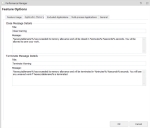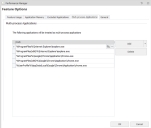Feature Options
Performance Manager Feature Options provides system-wide settings that affect all users with the deployed configuration.
To access the Feature Options, click Options in the Resources Setup ribbon.
In this section:
Feature Usage
For each Performance Manager feature, specify the following:
- Enabled - If selected, the feature is enabled.
- Passive Mode - If selected, the feature runs passively in the environment. Performance Manager makes no changes to the system, however it monitors and raises audit events where configured.
- Include System Processes - If selected, system processes are included for the feature.
Application Memory
Configure the content of the Close and Terminate warning messages. The following settings are available:
- Close Message Details - Configure the title and message displayed when applications are due to be closed for exceeding the specified application memory limit.
- Terminate Message Details - Configure the title and message displayed when applications are terminated for exceeding the specified application memory limit.
Excluded Applications
Add applications to exclude from Share Factor allocations and Thread Throttling policies.
Multi-process Applications
Add multi-process applications, such as web browsers, to efficiently manage CPU and memory resources for processes that spawn additional helper processes of the same name.
This feature allows multiple instances of the same process to be consolidated when considering the window’s state - foreground/background and maximized/minimized. For Microsoft Internet Explorer, this means each tab can be managed independently. For Google Chrome and other applications, Performance Manager calculates a summary window state so that the same foreground/background and minimized/maximized limits are applied to all matching processes based on their compounded windows state. This applies even if some matching processes have no windows or always have a fixed windows state, for example, if a helper process is always 'not visible' or in the background.
General
Apply general settings such as Share Factor Aggressiveness and Session Idle Timeout.
Specify the following options on the General tab:
-
Share Factor Aggressiveness - Use the slider to set a value for Share Factor Aggressiveness. This values determines how quickly Performance Manager reacts to changes in the CPU load.
When the slider is set to Max, Performance Manager reacts quickly to the changes in load. This can cause Performance Manager to take unnecessary action against processes that have brief spikes in CPU load and cause control over high demand processes to be lifted too soon if they briefly lower their demand for CPU resources.
When the slider is set to Min, Performance Manager monitors the effects of the changes over time, rather than taking immediate action. This can cause Performance Manager to take too long to control high loading CPU processes to free processes from control once they have definitively transitioned to a state of low CPU demand.
- System Memory Settings - Set whether overall system memory usage must reach a specified threshold before memory control is applied. Use the slider to set the threshold level.
- Session Idle Timeout - The Session Idle Timeout refers to the period when no keyboard and mouse activity takes place. This condition can be used in a rule to specify changes in resource allocations when the idle time reaches a set duration. The default setting is 10 minutes of no keyboard activity and mouse activity.
- Number of CPUs - Set the number of CPUs which can be used in CPU affinity settings in the CPU tab of a Resource Planning > Resource Allocations node.




